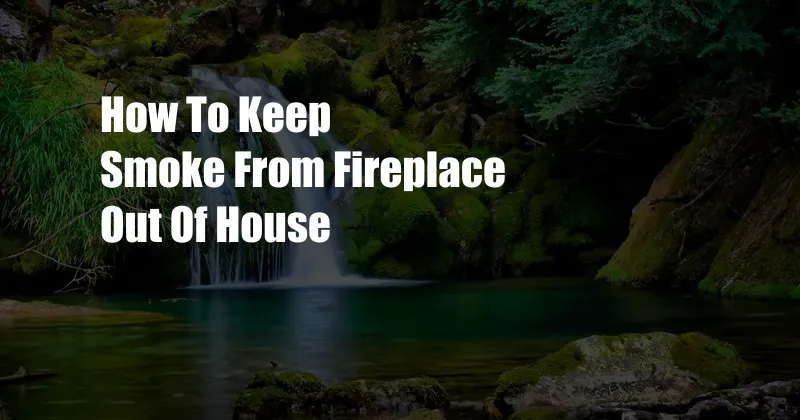
How to Keep Smoke from Fireplace Out of House
As a lifelong lover of cozy winter nights by the fire, I understand the frustration of dealing with smoke that escapes into the house. It can ruin a perfect evening, leaving your home smelling like a campfire and your belongings covered in soot. Over the years, I’ve learned a few foolproof techniques to keep smoke where it belongs – in the fireplace.
One of the most important factors in preventing smoke from entering the house is ensuring your fireplace is properly set up and maintained. This includes having a well-maintained chimney with a clean flue and a properly sized and installed damper. Neglecting these essential steps can lead to drafts and smoke backflow, allowing smoke to seep into your living space.
Damper Operation and Maintenance
The damper is a crucial component of your fireplace, acting as a barrier between the firebox and the chimney. When the fireplace is not in use, the damper should always be fully closed to prevent warm air from escaping and cold air from entering. Regularly inspecting the damper for proper operation and sealing is essential.
If you notice that the damper is not closing tightly, it may be due to warping, rust, or other damage. In such cases, it’s best to consult a professional chimney technician for repair or replacement. A properly functioning damper can significantly reduce smoke leakage and improve the overall efficiency of your fireplace.
Fire Management Techniques
In addition to ensuring your fireplace is in good working order, proper fire management techniques play a vital role in smoke control. One of the key factors is burning dry, seasoned firewood. Avoid using green or wet wood, as they produce more smoke and create more creosote buildup in the chimney.
Another crucial aspect of fire management is maintaining a steady and controlled burn. Instead of piling a large amount of wood into the firebox, start with a small fire and gradually add more logs as needed. This approach helps prevent excessive smoke production and allows for a more enjoyable burn.
Ventilation Strategies
Adequate ventilation is essential for proper smoke extraction. Ensure that the room where your fireplace is located has adequate openings, such as windows or vents, to allow for fresh air circulation. Opening a window near the fireplace can create a draft that helps draw smoke up the chimney.
In some cases, you may consider installing a specialized ventilation system for your fireplace. These systems use fans or blowers to create a controlled air flow, ensuring that smoke is effectively exhausted to the outside. While these systems can be more expensive, they provide a more efficient and reliable solution for smoke control.
Expert Tips and Advice
Here are some additional tips and expert advice to help you keep smoke from your fireplace out of your house:
- Use a fire starter or kindling to ignite the fire, rather than lighter fluid or newspaper, which can produce fumes.
- Avoid opening the fireplace door frequently, as this can disrupt the draft and allow smoke to escape.
- Never burn trash or other materials in your fireplace, as they can release harmful chemicals and create excessive smoke.
- If you experience persistent smoke problems, consider consulting a certified chimney sweep to inspect and clean your chimney and flue.
Following these tips and techniques, you can effectively keep smoke from your fireplace out of your house, ensuring a cozy and smoke-free ambiance for your winter gatherings.
FAQs on Fireplace Smoke Control
Q: Why does smoke from my fireplace enter the house?
A: Smoke can enter the house due to various reasons, including a poorly maintained chimney, improper damper operation, inadequate ventilation, or incorrect fire management techniques.
Q: How can I prevent smoke from leaking around the fireplace damper?
A: Inspect the damper for proper operation and sealing. If it’s damaged or warped, contact a chimney technician for repair or replacement.
Q: What is the best way to start a fire in my fireplace to minimize smoke?
A: Use a fire starter or kindling to ignite the fire, and avoid using lighter fluid or newspaper. Start with a small fire and gradually add more logs as needed.
Q: How often should I have my chimney cleaned to prevent smoke buildup?
A: The frequency of chimney cleaning depends on how often you use your fireplace. If you use it frequently, it’s recommended to have it inspected and cleaned annually.
Q: Should I open a window near the fireplace to improve smoke extraction?
A: Yes, opening a window near the fireplace can create a draft that helps draw smoke up the chimney. However, ensure that the window is not too large or too close to the fire, as this can disrupt the draft.
Conclusion
By following the advice and techniques outlined in this article, you can effectively keep smoke from your fireplace out of your house. Remember, a well-maintained fireplace and proper fire management practices are key to a cozy and smoke-free winter experience. If you encounter persistent smoke problems, don’t hesitate to consult a certified chimney sweep for professional assistance.
Are you interested in learning more about fireplace smoke control and other fireplace-related topics?